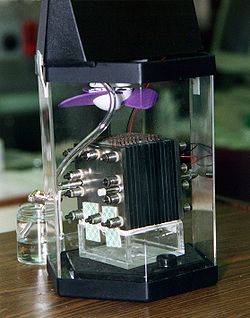
Back Direktmethanolbrennstoffzelle German Otsemetanool-kütuseelement Estonian Pile à combustible à méthanol direct French 直接メタノール燃料電池 Japanese 직접 메탄올 연료전지 Korean DMFC Dutch Ogniwo paliwowe zasilane bezpośrednio metanolem Polish Pilă de combustie cu alimentare directă cu metanol Romanian Прямой метанольный топливный элемент Russian Direct methanol fuel cell Thai

Direct methanol fuel cells or DMFCs are a subcategory of proton-exchange membrane fuel cells in which methanol is used as the fuel and a special proton-conducting polymer as the membrane (PEM). Their main advantage is low temperature operation and the ease of transport of methanol, an energy-dense yet reasonably stable liquid at all environmental conditions.
Whilst the thermodynamic theoretical energy conversion efficiency of a DMFC is 97%;[1] the currently[when?] achievable energy conversion efficiency for operational cells attains 30%[2] – 40%.[3] There is intensive research on promising approaches to increase the operational efficiency.[4]
A more efficient version of a direct fuel cell would play a key role in the theoretical use of methanol as a general energy transport medium, in the hypothesized methanol economy.
- ^ Umit B. Demirci (2007). "Review: Direct liquid-feed fuel cells: Thermodynamic and environmental concerns". Journal of Power Sources. 169. doi:10.1016/j.jpowsour.2007.03.050.
- ^ Ibrahim Dincer, Calin Zamfirescu (2014). "4.4.7 Direct Methanol Fuel Cells". Advanced Power Generation Systems. doi:10.1016/B978-0-12-383860-5.00004-3.
- ^ Keith Scott, Lei Xing (2012). "3.1 Introduction". Fuel Cell Engineering. p. 147. doi:10.1016/B978-0-12-386874-9.00005-1.
- ^ Pasha Majidi; et al. (1 May 2016). "Determination of the efficiency of methanol oxidation in a direct methanol fuel cell". Electrochimica Acta. 199.
© MMXXIII Rich X Search. We shall prevail. All rights reserved. Rich X Search